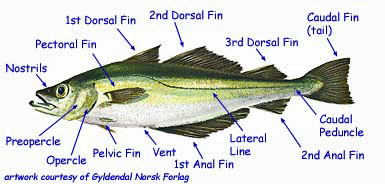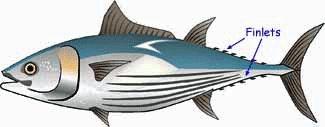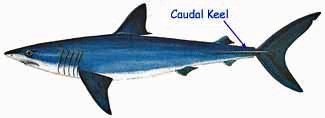- Home
- Fish Identification
- Parts of a Fish
Taking a Peek at
The Parts of a Fish
Just how do the various parts of a fish's anatomy work together to keep these fascinating creatures at home in their hazardous environment?
And what a risky life it is, with every fish species up to the Great White Shark himself being an item on someone else's lunch menu.
To survive, a fish must be able to attack, defend, run (well, swim as fast as he can) or hide - and sometimes all of these in quick succession.
Fortunately, all fish have evolved to master at least one of these attributes to give itself a sporting chance of success.
The External Parts of a Fish

Other than sharks, whose fins are more like the flippers we associate
with dolphins, most fish have fins constructed of spines (or softer
rays), supporting a webbed structure. These are the parts of a fish that
enable it to swim, although some species have developed their fins for
other purposes. Gurnards for example, can use their pelvic fins for
poking around on the seabed, and flyingfish use the pectoral fins for gliding over the ocean's surface.
The Dorsal Fin(s)
Saltwater fish can have either one or two dorsal fins but some, like the pollack in the example above, have three. Their function is to keep the fish on an even keel when it's swimming, and to assist in making tight turns.
Often the 1st dorsal fin in supported by sharp spines which the fish uses to defend itself. In some cases the spines are poisonous and can cause a very painful injury, as anyone who has stood on a weaver fish will confirm. The second and third dorsal fins normally have soft rays rather than hard sharp spines - altogether more friendly.
Saltwater gamefish - marlin and sailfish for example - with their huge sail-like dorsal fin can fold it into a groove on their backs when it isn't needed, reducing drag and providing maximum hydrodynamic efficiency which allows the caudal fin to drive them forward at maximum speed.
 |
Fish of the tuna and mackerel families have a number of small finlets between their final dorsal fin and the caudal fin, with a further set below. Precisely what these are for I've no idea. |
|
Fast-swimming fish species like the mako shark shown here often have one or two pairs of caudal keels which add stability to the caudal fin. |
 |
The Anal Fin(s)
|
All bony fish have at least one anal fin, and others like our pollack above, have two. Whatever the quantity they're there to stabilise the fish when it's swimming. Gurnards use their pectoral fins for 'walking' along the bottom, a technique which mudskippers have developed even further. |
The Pectoral Fins
|
The shark's pectoral fins are a more like a flipper than a fin, and their hydrodynamic design enable it to adjust its depth while swimming either slowly or at speed. |
The Pelvic Fins
|
These give the fish the ability to turn sharply, stop quickly, dive and climb through the water. |
The Lateral Line
|
This is a line of sensory receptors along the flanks of a fish which detects movement and vibrations in the water. |
The Preopercle and Opercle
|
These are the two parts of the hard gill cover used to protect the delicate gills within. They're only present in bony fishes - cartilaginous fishes like sharks, skates and rays seem to manage perfectly well without them. |
The Nostrils
|
Fish don't use these for breathing of course, but they can detect scent in the water through them - sort of like smelling. |
Recent Articles
-
Sea Fishing Rods and Reels Must Be Compatible for a Balanced Outfit
Mar 08, 21 08:30 AM
A quality reel fitted to a quality rod doesn't necessarily make it a quality outfit. Your fishing rods and reels have to be properly matched if you're to get the best out of them, and here’s how -
Essential Lure Fishing Tips That All Saltwater Anglers Should Know
Mar 08, 21 04:51 AM
Which single lure fishing tip applies to trolling, jigging, baitcasting, spinning, fly fishing and any other branch of lure fishing? Well, it is the one at the top of this list -
Vital Jig Fishing Tips That You Really Cannot Afford To Miss!
Mar 07, 21 10:20 AM
Essential jig fishing tips to help you select the right lure for successful jig fishing, together with the techniques required to get the most out of your jig fishing outfit




















New! Comments
Have your say about what you've just read! Leave me a comment in the box below.